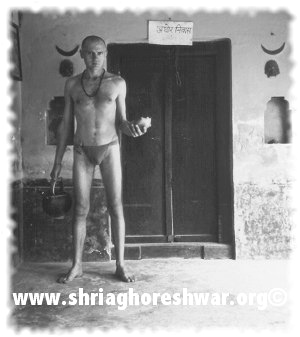The Difference between AGHOR, AGHORI AND AUGHAR Aghori vs aughar aghori vs Aghora
Source :- https://www.shriaghoreshwar.org/en/aghor-aghori-and-aughar/ Collection of Atricle By - Sri Anand Nath ji Aughar- Parama pujya sri sri sri Rajeshnath ji Aghori Pratheek,
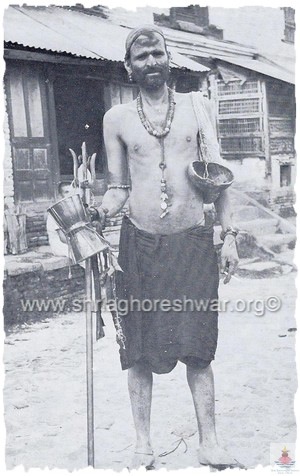
Aghor (a + ghor), a term usually rendered as absence of fear, dread, difficulty, is an inner state of being that can be gained through the spiritual discipline known as Aghor sadhana. The one who is instructed in this practice is known as Aghor, Aghori or Aughar. Aughar, (au + ghar) means “ The Other House”. The apex of Aghor state is Aghoreshwar, Lord of Aghor, a title of Shiva in some scriptures. The Aghora Mantra is already in the Vedas.
Shri Aghoreshwar Bhagwan Ramji
“O thou who wear the glory of Rudra
From fruit-bearing Aghoris
Shining with the brightness of stars
From all the goddesses
May everything be to thou
The highest among the fruits.
This supreme essence
May we know
In this immense splendour
May we immerse ourselves
This may Rudra bestows on us.”
Aghora Mantra
Aghor (a + ghor), a term usually rendered as absence of fear, dread, difficulty, is an inner state of being that can be gained through the spiritual discipline known as Aghor sadhana. The one who is instructed in this practice is known as Aghor, Aghori or Aughar. Aughar, (au + ghar) means “ The Other House”. The apex of Aghor state is Aghoreshwar, Lord of Aghor, a title of Shiva in some scriptures. The Aghora Mantra is already in the Vedas.

Baba Rajeshwar Ramji, Shri Aghoreshwar’s Guru
Aghor condition is obtained by the one who transcends the fourth state, Turiya, beyond the state of wakefulness, the state of dream and the state of deep sleep without dreams. The one who gains this condition is celebrated as Turiyatita, Avadhuta or Aghor. In his eyes nothing more is pure or impure because, transcending duality, he realized the Supreme Unity. He becomes like a dried seed, unable to produce karma.
Aghor sadhana is considered by Aghoris the straight way for the fourth state because it is perfect (Siddha) and heroic (Vira). It is Guruvani, passed through the word from Master to disciple, in an immemorial continuum. Aghor sadhana is a sum of practices that nowadays survives mainly in India and in the nearest zones.
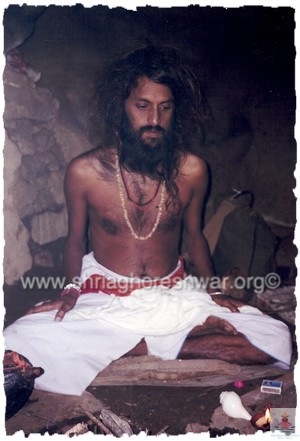
Baba Surya Dev Ramji – Sadhana in Girnar cave
It is difficult to reconstruct Aghori’s origin only through the quotations of critics and observers, the Aghori not having left any texts or chronicles. Their past before Aghoreshwar Baba Kina Ramji is completely shrouded in mystery and left to pure assumptions. These unknown sadhus didn’t have residences and they wandered on mountains or into the jungles. They lived in crematory grounds and paid visit to the sacred places, bringing comfort and their knowledge (medical, psychological, spiritual) to the population.

Shava Sadhana
Numerous are the theories proposed about Aghori’s origins. The most famous is that they come from Kapalikas, a presumed extinct school. Some think that Aghoris are Buddhists merged with Hinduism after the religion’s extinction from the Indian continent. In popular tales they were a non-vedic population or a tribe, probably established in the region of the rivers Narmada or Son. For still others, Aghoris may come from an archaic spiritual lineage now disappeared, maybe located in the heart of the ancient realm of Maghada, land of birth of modern Buddhism. Some say that it is possible that they come from other shaiva schools while others suggests that Kapalika, Sarbhanga, Brahmanishta, Avadhuta, Abhyadhar, Aghor and other names, used in different times and different places, are synonymous. Hindus regard Aghoris as coming directly from Shiva. In a study done in Kashi about organisations of sadhus shaiva, vaishnava and sadhus of minor factions, Aghoris aren’t placed in any of these religious divisions.
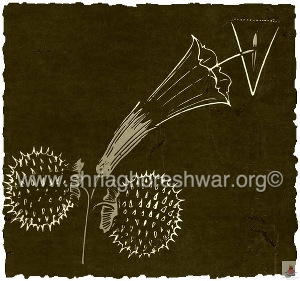
Shiva – Shakti
The only original Aghori literature includes the works left by Baba Kina Ramji and the many volumes published under Baba Aghoreshwar Ramji’s direction and a little more.
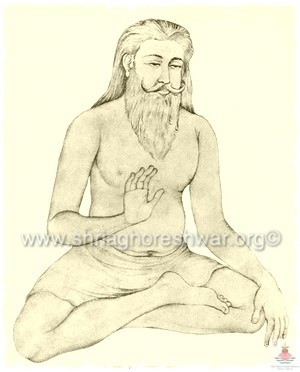
Baba Kina Ramji
Shri Aghoreshwar Bhagwan Ramji, known as the last leader of modern Aghoris, said many times in his speeches: “Aghor is not Shaiva, Vaishnava, Shakta or Tantra. Aghor is the essence of all traditions.” Regarding Kapalikas in one of his writings he simply describes them with an adjective: Celestials. Aghoreshwar is synonymous for Kapaleshwar.

Kapalika, Kathmandhu – G. Tucci 1952
In accordance with mythology the first Kapalika is Shiva himself, in his terrific Bhairava form. The story, as told in Puranas, tells that He cut off one of Brahma’s heads in a fit of rage. Guilty of the loathsome crime of brahmanicide, he was condemned to wander with the skull of his victim stuck to his hand and to use it as begging bowl and food bowl. After twelve years he arrived in Kashi (Varanasi) and the Kapal (skull) spontaneously came off his hand, falling in the place now known as Kapalamochana.

Aghor Ganesh
The oldest mentions of Kapalikas have to be found in the Smritis (Yajnavalkya and Vishnu), written maybe few centuries before Christ. They appear in the writings of Jains and Buddhists too. The Buddhists were to be so deeply influenced by Kapalikas’ as their practises began to impregnate Mahayana and the different tantric currents. The protagonists of some literary Indian works of the first millennium of the current era, described with a tone sometimes grotesque and sometimes sinister, have names that can be traced back to Aghor and Kapalikas ascetics. Quoted in many stories of Chinese, Arab and European travellers and chroniclers, it seems like if they were in great numbers until the Middle Ages. The ancient observers remarked that among the wandering ascetics many were bringing skulls (they were Kapalikas).

Baba Kalu Ramji, Baba Kina Ramji, Baba Bija Ramji, Baba Ram Jivan Ramji
Krin Kund Sthal, Kashi
An uncontaminated line survived invasions, persecutions, destructions, cultural absorption and flourished in the wonderful expression developed in Kashi by the extraordinary Baba Kalu Ramji and by the very high Baba Kina Ramji, beginning to be known as Aghor. Baba Kina Ramji became famous for the legendary feats of his existence, for the fights with rajas and nawabs of that time in sadhus’ and poor people’s favour, for having revived tradition and promoted dialogue among the main Hindu currents and among the religions but most of all thanks to the work for the weakest social classes and their defence.

Mahasiddha Shri Dattatreya Yantra
Baba Kina Ramji, during his long existence, visited the places linked to Girnar and the Himalaya but it’s in Varanasi (Kashi), at Krin Kund Sthal, that He gets the final diksha to Aghor sadhana by the striking Baba Kalu Ramji. Both historical characters, they are the link of the modern Aghor expression to the ancient roots. This line of wandering and unknown sadhus got organized and entered local society, bringing an important contribution in those times of big difficulty.

Shri Dattatreya Gurudev
Shri Dattatreya is the Patron and ideal Master of Aghoris, and his symbolic abode is located on Girnar mountain. Between Shri Dattatreya’s peak, with the Charan Paduka, footprints of the Master and Goraknath’s peak, with his Karaon (the sandals) and Dhuni, rises Aghori’s peak, Aghori Shila, dedicated to Baba Kina Ramji, bare, inhospitable and inaccessible. This essentiality without any representation is maybe symbolic of the Aghor state?
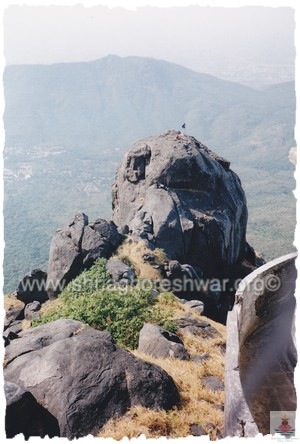
Baba Kina Ram Aghori Shila, Girnar
Their ancientness, the uninterrupted link with a remote spiritual knowledge of mankind, the practises considered bearers of incredible spiritual powers (Siddhis), their outwardly inaccessibility and isolation, contributed to generate stories and references most of the times imaginary. The absence of promotion through texts, the lack of interest in religious disputations, the rejection of the orthodox taboos and of the caste prejudice, then gave birth to a doubtful literature, often made by detractors, in which disgusting and aberrant behaviours are ascribed to the Aghoris. Ignorance, superstitions and popular beliefs, rumours, imitative behaviours played by disturbed or sly figures, moulded a stereotyped distorted image far removed from reality.
Readings:
Y. N. Chatturvedi Aughar Bhagwan Ram
Shri Sarveshwari Samooh Aghoreshwar Smrti Vachanamrit
Shri Sarveshwari Samooh Aghoreshwar Samvedan Sheel
Shri Sarveshwari Samooh Aghor Guru Guh
Shri Sarveshwari Samooh Aghor Ram Kina Katha
I. Cucoch Il divino e pratico messaggio di Aghoreshwar (1985)
I. Cucoch I discorsi di Baba Aghoreshwar (1996)
Akinchan Ram Aghor Vachan Shastra
K. K. Verma Aghor Tradition and an Aghor in India
H. Balfour Life History of an Aghor Fakir
H.W. Barrow On Aghoris and Aghoraphantis
D.N. Lorenzen The Kapalikas and Kalamukhas
S. Sinha e B. Saraswati Ascetics of Kashi
What's Your Reaction?


































































